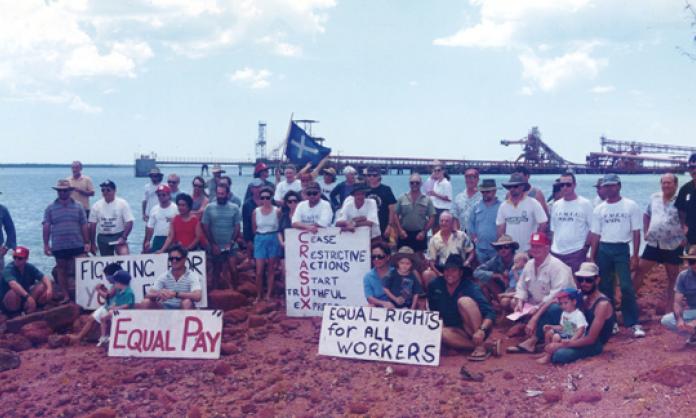When my plane dips below the clouds, the red earth and harsh scrub of Cape York come into view. I’m travelling to the small mining town of Weipa, situated on the Gulf of Carpentaria in far north Queensland. Just metres below the topsoil are some of the world’s largest known deposits of bauxite – the rust-coloured ore that is the main source of aluminium.
Yes, there’s a lot to be found under the surface in Weipa. Twenty years ago, this place was the site of a momentous showdown between Australian workers and employers. It was a landmark industrial dispute of the ’90s – the Weipa strike.
The plane banks left, and suddenly the mine surrounding the township is in sight. Vast, open-cut plains of orange earth are dotted by tipper trucks. In the distance is the Weipa port, where, around the clock, workers load enormous vessels transporting bauxite to Gladstone, Tasmania, and New Zealand for refining and smelting.
Twenty-four hours a day, seven days a week, more than 1,000 workers – working four days on, four days off – extract, wash and transport millions of tonnes of bauxite a year. This year, Rio Tinto Alcan reported record production of 26.5 million tonnes.
Waiting at the airport for me is Esther Rutherford, a proud unionist and nurse whose family was involved in the 1995 strike. Her husband Dave, an electrician at the mine, was one of the strikers. “Over there is picket point, that’s where we launched the floating pickets from”, she says pointing out the car window as we drive into town, “and the Aboriginal elders gave us permission to set up a more permanent camp over there”.
I’m not the only one flying into town this weekend. Dozens of former Weipa workers have come back to celebrate the 20th anniversary of their struggle.
One of them is Nigel Gould, who at the time of the strike was the CFMEU Weipa lodge secretary (and also president of the Weipa Tennis Club). “It was all to do with equal pay for equal work”, he says of the strike. “The company enticed people onto these individually negotiated, non-union contracts, with big pay rises, a lot of money – which was what most people went to Weipa for. But they didn’t realise what giving up their ability to collectively bargain in a union would mean for their conditions.
“Those conditions were hard fought for by unionists, our forefathers, and we weren’t gonna let them down.”
At the time, their employer – then known as Conzinc Riotinto of Australia, or CRA – was playing a pioneering role in the Australian industrial landscape.
A global recession coupled with an incessant lust for profits put the Australian capitalist class on the offensive. Companies like CRA knew that the main obstacle to bigger profits was the trade unions.
For most of last century, Australian workers’ wages and conditions were set by the award system. It was a centralised system that allowed even the most isolated and industrially weak sections of the working class to benefit from the bargaining power of the strongest.
Break that connection and you could break the unions. CRA’s strategy was to shift workers onto individual contracts.
Its first move was in 1990 at its Tiwai Point aluminium smelter in New Zealand. There, 1,400 workers were conned with large pay increases into signing individual contracts. In other places, where workers cottoned on to CRA’s game and put up resistance, the company launched a ruthless legal attack. In 1992, when workers at its Hamersley iron ore mine in the Pilbara in Western Australian struck for 16 days against non-union labour, the company hit them with a $70 million damages claim.
By the mid-’90s, the majority of the workforce at CRA’s non-coal operations had been shifted – with the carrot or the stick – to non-union agreements.
At Weipa, only 75 of the then 700-strong workforce resisted the individual contracts and remained on the award. The 75 recognised the long-term ramifications of individual contracts. Already, in 1991, the company had cut training and overtime pay and had started going after conditions.
By October 1995, just before the strike, some unionists (such as Nigel, who was a truck driver) were being paid up to $20,000 a year less than a contract employee doing the same work. It was a time of frustration.
Over a beer at the official commemoration event that night, I ask a group of strikers what led them to decide to strike.
“We’d tried everything legally”, someone explains. I learn that for two years after the introduction of the individual contracts in 1993, the various Weipa unions – the CFMEU, ETU, AMWU, AWU and CEPU – organised through the Weipa Industrial Site Committee (WISC), were embroiled in a fruitless and protracted legal battle in the Australian Industrial Relations Commission.
On Friday, 13 October, after the company tried more stalling tactics at a hearing in Cairns, the WISC convened a mass meeting at the local footy oval to decide what to do. The workers had had a gutful – two years going through the right channels had got them nothing. The vote was put for an indefinite strike. The decision was unanimous.
First battles
The workers immediately got organised. A strike fund was set up, media releases sent out and the case put to non-union workmates to join the campaign.
When 83 vehicles blockaded the Mission River Bridge, which connects the Andoom mine to the town, Weipa had its first ever picket.
For a time, nobody could get to work. But the company soon got around the bridge picket by ferrying non-union workers across on a train carriage. The strikers needed another strategy. They decided to blockade the ore freighters at the Weipa Port with floating pickets.
Nigel explains: “Well, the WISC – that’s all the unions combined – we had our think tank there. And it was just all the unions working together, working out where are the company’s weak spots, where are their vulnerabilities? And where was our expertise? And of course, we love our fishing up here! So we decided to hit their hip pocket. Of course, if they can’t get the ore out, they can’t make any money!”
For weeks, courageous strikers risked not only arrest but their lives, ducking and weaving their tinnies around the colossal bulk carriers. Pressure continued to mount on CRA.
Solidarity spreads
The breakthrough, according to Nigel, came when maritime and coal workers around the country answered calls for solidarity.
“They were inspirational”, he says. “The coal workers were the ones that led it out of the gates. They were the ones who said, right, we’re not gonna let our comrades be screwed.”
It started on 8 November, with mineworkers at CRA’s two biggest coal operations in Queensland – Blair Athol and Tarong – walking off the job for 24 hours and pledging their full support to the Weipa strikers. A day later, maritime workers aboard the River Embley, one of the bulk carriers unable to leave Weipa due to the floating pickets, stopped work for 24 hours.
Rank and file unionists at CRA’s operations across the country were livid at the company’s union-busting tactics and were itching to take action. Weipa was the opportunity they’d been waiting for.
By 10 November, 3,000 workers at CRA’s coal and coke works throughout Queensland and NSW were on the grass. Weipa was quickly becoming a national news story, and journalists and TV crews began flooding into town. Prime minister Paul Keating was urged to intervene as big business began to fret not just at the thought of lost profits, but of a reawakening trade union movement – dormant for so long during the Accord years.
Phones were running hot at CFMEU offices around the country with rank and file unionists demanding their turn to take solidarity strike action. By now, port workers around the country had banned the handling of all CRA export coal. Maritime workers launched a three-day national strike on 15 November, the same day the CFMEU announced a seven-day nationwide coal strike, to begin the following week.
At a press conference in Sydney, an ACTU representative said that unions were ready to take action against CRA in other industries, including manufacturing, power, oil, gas and transport. Nigel and his comrades were surprised by the many non-mining workers who indicated they too were ready to strike.
“Even not so active unions said, OK, this is the line in the sand, we’re all gonna get behind you.”
On 17 November – day 36 of the Weipa workers’ strike – there was a national maritime strike, an approaching national coal strike and a slated ACTU meeting to discuss spreading the campaign to other industries. By 19 November, 25,000 coal miners were out across the country, costing the bosses an estimated $20 million per day. Enthusiasm for the strike was so great, in fact, that 2,000 coal miners across six mines walked off the job 30 hours early.
Partial win, important lessons
In the end, the Weipa workers did win what they were after – “equal pay for equal work” – but at a cost. The leadership of the ACTU had no real intention of escalating the dispute into a national stoppage, which they knew could have very quickly transformed from a purely defensive action into an all-out working class offensive, winning back the wages and conditions lost during the collaborationist Accord years.
Instead, ACTU secretary Bill Kelty ordered the unions back to work, winding down the struggle into a dispute in the Industrial Relations Commission. CRA now had the ball back in its court. While ceding the 75 unionists their right to union representation, this came at the cost of award conditions, which were eroded to match the individual contracts.
The Weipa strike proved that our movement’s strength lies in the economic muscle we flex when we withdraw our labour, and the solidarity this can inspire among other workers.
Two years of arbitration left the Weipa unionists frustrated and thousands of dollars out of pocket, while a return to “old school” unionism – going on strike, setting up pickets, and calling for support – won them equal pay for equal work, and for a brief moment revived union militancy around the country.
“It was the best seven weeks of my life”, one of the strikers confessed to me later that evening. “The unity… having control over something. It wasn’t just about us, it was about the future generation.”
Twenty years ago the Weipa strikers drew a line in the sand. Their struggle shows that there is no substitute for strikes and working class solidarity. If our side is to advance again, this is a lesson we cannot continue to ignore.











